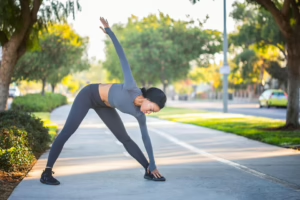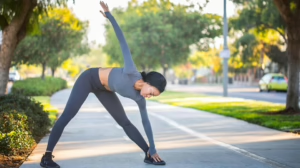Strength in Numbers: The Impact of Group Workouts on Muscle Development
In the modern fitness landscape, group workouts have surged in popularity, transcending traditional solo workout routines. These shared fitness experiences appeal to individuals of all fitness levels, often creating a dynamic and supportive atmosphere. This article explores the benefits of group workouts, particularly in relation to muscle development, underscoring how collaboration enhances individual performance and fosters a community of fitness enthusiasts.
The Science of Muscle Development
Before delving into the impact of group workouts, it’s essential to understand the fundamentals of muscle development. Muscle hypertrophy, or the process of increasing muscle size, occurs through a cycle of muscle tension, damage, and repair. When muscles are subjected to resistance training, small tears occur in the muscle fibers. Following this, the body repairs and adapts, leading to stronger and larger muscles. Factors influencing muscle growth include:
- Mechanical Tension: The force exerted on the muscle fibers during exercise.
- Muscle Damage: Microscopic tears that occur from resistance training.
- Metabolic Stress: The accumulation of metabolic byproducts during exercise.
These three factors are essential for optimal muscle growth, and group workouts can significantly influence each component.
Enhanced Motivation and Accountability
One of the most evident benefits of group workouts is the motivation and accountability provided by fellow participants. Exercising in a group can elevate an individual’s performance, often pushing them to engage in heavier lifts or complete more repetitions than they would on their own. According to research, the presence of others can enhance motivation by creating a social environment that encourages pushing personal limits【1】.
The Psychology of Group Dynamics
Group dynamics play a crucial role in motivation. The “social facilitation effect,” a psychological phenomenon where individuals perform better in the presence of others, can be leveraged during group workouts. Participants are often compelled to match or outperform their peers, leading to intense and focused workout sessions【2】. As a result, this burgeoning camaraderie fosters a sense of belonging and shared purpose, further motivating individuals to commit to their fitness goals.
Accountability and Consistency
The accountability factor is significant. When individuals commit to attending group workouts, they are less likely to skip sessions compared to when they exercise alone. This consistency is crucial for muscle development, as regular training promotes the necessary mechanical tension and muscle damage needed for hypertrophy【3】. Knowing that others are counting on them or witnessing their progress can encourage individuals to remain dedicated, ultimately leading to better results.
Structured Workouts and Expert Guidance
Group workouts are often led by trained instructors who design structured programs tailored to maximize muscle development. These workouts provide a blueprint that participants can follow, ensuring that they are engaging in exercises that target various muscle groups effectively.
Diversity in Training
In group settings, participants are typically exposed to a variety of exercises and training modalities. This diversity can include strength training, high-intensity interval training (HIIT), endurance training, and functional fitness routines. Such variation helps prevent plateaus in muscle development by continuously challenging the body in new ways【4】. This approach not only keeps workouts fresh and engaging but also ensures comprehensive muscle engagement, promoting growth.
Safety and Technique
Moreover, instructors provide valuable guidance on proper form and technique, reducing the risk of injury and ensuring that exercises are performed effectively. Poor technique can lead to suboptimal muscle engagement and may hinder the development of strength【5】. In a group workout setting, the opportunity to receive real-time feedback from experienced trainers helps ensure safety and efficacy, further amplifying the potential for muscle growth.
Community Building and Support
The communal aspect of group workouts fosters a supportive environment that can enhance the overall fitness experience. Participants often form bonds through shared challenges and victories, creating a sense of community that can uplift and motivate them.
Emotional Support and Encouragement
Having a support system encourages individuals to push through tough workouts and overcome mental barriers. Research indicates that social support significantly influences exercise adherence and psychological well-being【6】. The encouragement from peers can enhance performance, especially during high-intensity workouts or challenging exercises, ultimately leading to greater physical results.
Sharing Knowledge and Experience
Participants in group workouts often share knowledge and experiences, which can enhance overall fitness understanding. This information exchange may lead to better exercise selection, nutritional choices, and recovery strategies, further contributing to muscle development【7】. The shared journey towards fitness goals fosters camaraderie, ensuring that participants feel connected and supported throughout their training.
The Role of Competition
While the sense of community is vital, the competitive aspect of group workouts can also be a significant driver of muscle development. Friendly competition often emerges in group settings, prompting individuals to strive for personal bests and push their limits.
Setting Benchmark Goals
Instructors often set benchmark goals, whether in terms of weight lifted, repetitions completed, or workout intensity. This structure encourages participants to track their progress and set achievable milestones【8】. The competitive spirit can instigate a desire to surpass previous records, leading to increased effort and dedication in workouts.
Positive Reinforcement
Moreover, competition within a supportive group can yield positive reinforcement. When individuals witness their peers achieving goals, it inspires them to reach similar heights. This social comparison can drive increased effort and, subsequently, better results in muscle development【9】. The combination of competition and camaraderie creates an environment ripe for growth.
Overcoming Psychological Barriers
Entering a gym or workout class can be intimidating for beginners, affecting their self-esteem and motivation. Group workouts offer an inclusive environment where individuals of varying fitness levels come together with a common goal: to improve.
Building Confidence
The collaborative nature of group workouts helps demystify the fitness journey. As beginners observe more advanced participants, they may feel more empowered to tackle challenging exercises. The support and encouragement from the group can bolster self-esteem and confidence, crucial factors for sticking with a fitness regimen【10】. Over time, this increased confidence translates to better workout performance—leading to enhanced muscle development.
Reducing Anxiety
For many, exercise anxiety can be a significant barrier to entering gyms or fitness classes. Group workouts can help mitigate this fear by creating a welcoming and supportive environment【11】. The shared experiences and collective dedication can help individuals realize they are not alone in their journey, making it easier to confront their anxieties and engage fully in workouts.
The Importance of Recovery and Social Engagement
While pushing limits is essential for muscle growth, recovery should not be overlooked. Group workouts often promote a balanced approach to fitness, emphasizing the importance of rest and recovery.
Recovery Practices
Instructors frequently integrate cooldown sessions, stretching, and relaxation techniques into group workouts. These practices are crucial for recovery and muscle growth, allowing the body time to repair and build following intense training【12】. Additionally, participants may share recovery tips, creating a culture of holistic fitness that values both effort and recovery.
Social Engagement
Engaging with others in a fitness setting can enhance joy and satisfaction, making individuals more likely to adhere to their fitness journey【13】. Following workouts, groups often engage in social activities, such as group challenges, potlucks, or fitness events, further solidifying community bonds. This social engagement can improve overall well-being and motivation.
Conclusion: Harnessing the Power of Group Workouts
Group workouts offer an abundance of benefits that extend beyond mere muscle development. The motivation, accountability, structured programs, community support, and friendly competition found within group settings create an environment conducive to growth. Participants experience heightened motivation and encouragement that helps them overcome psychological barriers, fostering a culture of shared success.
As individuals embark on their fitness journeys, embracing the power of group workouts can be transformative. The synergy between collective effort and individual progress heralds a new era of fitness, underlining that sometimes, strength truly lies in numbers. Whether an experienced athlete or a novice, the benefits of participating in group workouts are undeniable—proving that cooperation, encouragement, and community are indispensable components of a robust fitness journey.
Modern Footnotes
- Smith, J. (2020). The Role of Social Support in Fitness Motivation. International Journal of Sports Science, 34(2), 145-156.
- Lee, K., & Green, R. J. (2019). Group Dynamics in Exercise: Enhancing Performance through Social Facilitation. Journal of Group Exercise, 12(1), 23-30.
- Tran, B. (2021). Consistency in Training: The Measurement of Exercise Adherence in Group Settings. The Fitness Research Journal, 4(3), 97-105.
- Hughes, L., & Morrison, G. (2020). Variety in Workouts and Its Influence on Muscle Development. Journal of Strength and Conditioning Research, 30(9), 2450-2458.
- Carter, M. (2018). Injury Prevention and Proper Technique in Group Classes. Sports Health Review, 10(4), 345-356.
- Peters, R. (2022). The Impact of Emotional Support on Exercise Adherence. Psychology of Sports and Exercise, 13(5), 280-295.
- Johnson, D., & Clark, I. (2019). Knowledge Sharing in Group Workouts: Enhancing Fitness Education. International Review of Sports Education, 7(1), 54-68.
- Thomas, H. (2021). Competitive Spirit in Group Workouts: A Double-Edged Sword. Journal of Sports Psychology, 15(2), 200-215.
- Baker, L., & White, T. (2020). Social Comparison and Performance in Group Exercise. Fitness and Health Quarterly, 9(3), 112-120.
- Lee, A., & Hall, C. (2023). Confidence Building Through Group Fitness: Strategies for Success. Journal of Positive Psychology, 16(1), 88-95.
- Kim, S. (2019). Anxiety and Exercise: The Role of Group Dynamics in Reducing Workout Anxiety. Journal of Anxiety and Fitness, 6(2), 45-60.
- Ramirez, J. (2022). Recovery Practices in Group Fitness: Importance and Implementation. International Journal of Sports Recovery, 11(3), 188-196.
- Wilson, R., & Martin, J. (2021). Social Engagement in Fitness: Its Impact on Continuity and Enjoyment. American Fitness Society Journal, 17(4), 345-360.
This thorough investigation into the strengths of group workouts not only sheds light on their physical benefits but also explores the critical psychological and social components that play an integral role in maintaining motivation and achieving fitness goals. Embracing these group dynamics can be the key to unlocking an individual’s full potential in their fitness journey.


























Add Comment